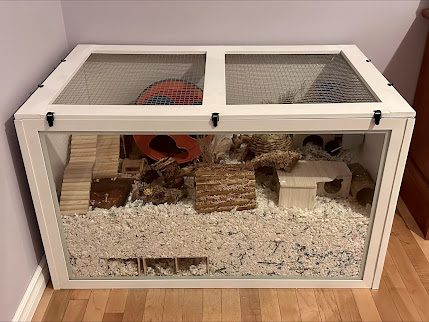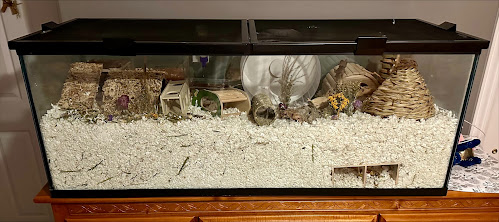Hamsters 101
I’ve loved hamsters since I was a little girl. They’re wonderful, adorable, fun little animals. My home doesn’t feel complete without one. However, that doesn’t mean they’re for everyone, especially young children, and they are absolutely not suitable for a classroom pet.
THE BASICS
Hamsters are most active in the late evenings and early mornings, meaning children may rarely see them. Waking them up during the day is very stressful for them and should be avoided. When they’re awake, they can be loud and keep children (and you!) awake.
Hamsters are
fragile prey animals. It can be difficult to earn their trust and bond with
them, and this process must be taken at their pace while respecting their
boundaries. If they are startled or frightened, they may bite to defend
themselves and this can be painful. Being bitten can be upsetting for children,
and if they flinch, they could accidentally drop and injure the hamster. All
hamsters are different, and some may never enjoy being handled. Some species
are nippier than others.
Hamsters’ housing needs can be expensive to meet. People might argue that it’s “just a hamster” and the guidelines are excessive. While hamsters’ lives may be short, they still deserve the best life we can provide them. It’s the only life they get. If you plan to ignore ethical guidelines, do not get a hamster. This includes committing to keeping them for their lifespan, which is about two years depending on the species.
The cost of veterinary care must also be considered. Hamsters may require a vet if they become unwell or for end-of-life care to ease their passing. Because they are exotic pets, veterinary care can be significantly more expensive.
Most species of hamsters are solitary animals that MUST be housed alone. Putting them together even for a short time can lead to nasty and dangerous fights. Syrian hamsters and Chinese hamsters are strictly solitary. Some species of dwarf hamsters can be housed together under special circumstances with experienced keepers.
There are five domesticated species. Syrians, also known as teddy bear or golden hamsters, are the largest and most common. Dwarf and Chinese hamsters are smaller and quicker. Dwarf hamsters sold in pet stores are hybrids of two species and it’s considered highly unethical to breed them.
KEY CARE POINTS
- Store-bought cages are inhumanely undersized. Although ethical guidelines vary by country, the ideal size is 5000 square cm/777 square inches of continuous floor space (not levels or connected cages). That’s 100x50 cm or ~40x20 inches. Canada’s ethical minimum is 80x50 cm/600 square inches. Keep reading for alternatives to store-bought cages.
- Hamsters are ground dwellers who burrow. They need at least 8 inches of bedding and enclosures should be approximately 50 cm/20 inches deep.
- Bar-biting, monkey-barring, pacing, and trying to escape are signs of stress due to inadequate care, such as an undersized enclosure without enough bedding or enrichment.
- Pine and cedar shavings are toxic to rodents’ respiratory systems. Use aspen, hemp, or shredded paper products instead. Don’t buy fluffy nesting material (cotton, kapok) because it can become wrapped around limbs and cause internal blockages.
- Wheel diameters should be at least 10-12 inches for Syrians and Chinese and 8 inches for dwarfs. Running surfaces must be made of solid plastic or wood. Ridges, holes, and rungs can cause injuries.
- Exercise balls are unsafe and should not be used.
- Hamsters sold in pet stores come from inhumane rodent mills and are often rife with health issues. Please consider adopting from a shelter or rescue instead. There are a few ethical breeders out there but do your research first.
- Local note for Sault Ste. Marie: Both of my hamsters are from our humane society, but they’d been placed at the Trunk Road Pet Valu for adoption. This was clearly indicated on the aquariums in which they were housed and the transaction was processed separately. I wish all pet stores would do this instead of trucking in animals from rodent mills.
HOUSING
Research has led to an evolution in ethical hamster care. Unfortunately, pet stores and the manufacturers of pet supplies continue to sell products that range from inhumane and unethical to dangerous. The same applies to all rodents kept as pets.
With very few exceptions, hamster cages are cruelly undersized. The ideal size is 5000 square cm/777 square inches of continuous floor space. That’s 100x50 cm or ~40x20 inches. Canada’s ethical minimum is 80x50 cm/600sq inches. This cannot be divided into levels or separate cages connected by tubes. Cages with extra levels are unnatural (hamsters are ground dwellers) and dangerous because the hamster can fall and injure itself. Plastic tubes are too narrow for Syrians and provide inadequate ventilation. Tubes that run outside the cage can become disconnected, allowing the hamster to escape.
Hamsters have an instinctive need to build burrows that require at least 8 inches of bedding, but 30+ cm is even better. Enclosures should be around 50 cm/20 inches deep. The more you compact the bedding, the better the burrow holds. Most cages can’t accommodate that much bedding because they’re built with shallow trays and metal bars.
Photo: My Syrian hamster Tyrion poking his head up from his burrow. He didn’t see his shadow, predicting a warm holiday season.
A few commercial cages meet requirements, including some (but not all) made by Niteangel, PawHut, and Bucatstate. They’re available online through Amazon, Wayfair, etc. Alternatives are aquariums (minimum 40-gallon breeder), custom-made, and the relatively inexpensive bin cage.
Bin cages are made from clear, colourless storage totes. The largest such bin I’ve found is the Sterilite 189L, which you can find at Walmart for under $50. Even that is a bit small in my opinion, but it’s much more humane than anything from a pet store. Obviously, your hammy needs to breathe, but you don’t want to worry about Houdini escaping. Cut large openings in the lid and attach rodent-proof wire mesh, NOT chicken wire. I fasten mine using zip ties. You can find steel mesh with half- or quarter-inch openings at Home Depot for about $25.
I have 3 different types of enclosures in my home (see photos). My rescued feeder mice live in the 189L bin cage. One of my Syrians lives in a 75-gallon aquarium, while the other lives in an enclosure I built from IKEA Komplement shelves. You can find ideas for custom builds on YouTube and Pinterest.
BEDDING
Do not use pine or cedar! They’re toxic to rodents’ respiratory systems. Aspen and hemp are safe and best mixed with unscented paper-based bedding that’s readily available from pet stores and online. Paper bedding can also be used alone. I prefer the white paper products to avoid dyes. This also makes it easier to spot dirty bedding and to keep an eye on my hamsters’ health (e.g. blood in urine).
Do not buy the fluffy, cottony nesting material! It can get wrapped around little toes, stuck in cheek pouches, and cause fatal intestinal blockages. Hamsters will use their bedding for their nest, or you can tear up toilet paper (not Kleenex, which can block their intestines).
How often you clean your hamster’s enclosure depends on its habits. Victoria Raechel has an excellent YouTube video on the topic. In fact, she’s an excellent source of information in general.
https://www.youtube.com/watch?v=JFep1JycdVA
WHEELS/EXERCISE
It’s no surprise that undersized cages come with undersized wheels. These cause uncomfortable spinal curvature and can lead to spinal problems. Your hamster’s back should be flat and straight when running on its wheel. Syrian and Chinese hamsters need wheels that are at least 10 inches in diameter, but 12 inches is even better. Dwarf hamsters need an 8-inch. Make sure the running surface is made of solid plastic or wood. Anything with holes, rungs, or openings can cause injuries.
Saucer discs should be avoided because they cause the hamster to run at an unnatural angle.
Do not use exercise balls! Hamsters have poor vision and mostly navigate the world using smell. Balls block most of the scent available to them. Because they’re prey animals, being in a ball is frightening—there’s nowhere to hide. Also, their legs and feet can get caught and injured in the ventilation slats.
The best and
safest source of exercise and boredom-busting outside their cage is a small-animal
playpen or a hamster-proof room in which they can roam free. Even a dry,
plugged bathtub will work. Sitting in it with them can help with the
bonding/taming process. Fill the play area with toys (see next section) to
enrich the environment. Use a container to securely transport them between
their enclosure and the play area.
CLUTTER IS GOOD!
Active and curious little creatures, hamsters become bored quite easily. Their cages need plenty of enrichment items and toys. At least two hideaways are a must, as is a sandbox. Hamsters like to use sand for bathing. Some will even potty-train themselves in it. Be sure the sand you buy doesn’t have added calcium and is low dust, such as some Reptisand products. You can buy play sand (Home Depot, etc.), but it must be baked first.
Add bridges, huts, branches (make sure it’s a hamster-safe species—Exo Terra terrarium branches are great!), natural cork products (flat pieces or rounds), dried sphagnum moss, and so on. They also enjoy different substrates to dig in, such as shredded coconut husk. Many of these items can be found in the reptile section. If you aren’t sure if it’s safe for hamsters, ask or check (reputable!) online sources. Freeze natural products for at least 48 hours to kill any unwanted hitchhikers. Avoid toys and decorations made of resin because they can have sharp edges, especially if chewed on.
A note about bendy bridges. Most have gaps between sections in which legs and feet can get caught and injured. Either invest in a more expensive brand that has uniform pieces or use non-toxic school glue and sphagnum moss to fill in the gaps.
Check YouTube or Pinterest using the keyword “hamsterscaping” for enrichment ideas. This is another excellent video from Victoria Raechel that demonstrates how an enclosure should be set up.
https://youtu.be/kaVqfcZTA7E?si=I36Y5ZTSIm1KnBT2
FOOD
Foods with timothy hay as the main ingredient aren’t recommended. Your hamster should eat a combination of seed mix and lab blocks (nugget-looking things). Supplement these daily with fresh, clean produce. Kale, Romaine lettuce, cauliflower, broccoli, bell peppers, zucchini, cucumber, and peas are favourites in my house.
The Ontario Hamster Club is another excellent source of information and has an extensive list of safe and unsafe foods as well as a list of recommended commercial foods. You can find them on Instagram, their Facebook page, and connect with fellow hamster lovers through their Facebook group.
https://www.facebook.com/groups/ontariohamsters
These are my preferred foods:
- Versele-Laga Crispy Muesli seed mix
- Versele-Laga Nature Hamster seed mix
- Kaytee Forti-diet lab blocks
QUESTIONS?
Feel free to ask. If I don’t know the answer, I’ll do my best to point you in the right direction.
Photo: The enclosure I built for Misha Smallins using IKEA Komplement shelves and a homemade lid using materials from Home Depot and Amazon.
Photo: The 189L Sterilite bin that houses my rescued feeder mice (Phoebe, Rachel, and Monica)
Photo: Tyrion Hammister’s 75-gallon aquarium with Exo Terra hinged screen lid and clamps
Many thanks to Elise Bishop from the Ontario Hamster Club for her invaluable input!





Comments
Post a Comment